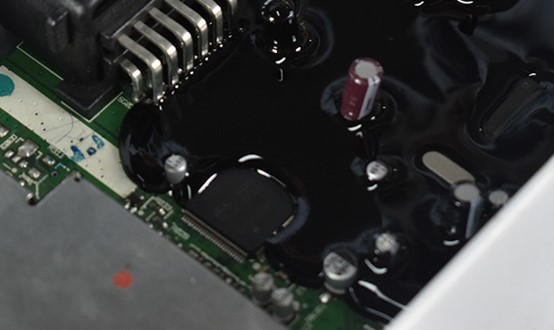1. Can the condensation type 10:1 potting glue be heated and cured?
During the curing process of condensation products, small molecules are produced, so they are not suitable for heating and curing. Generally, it takes more than 12 hours for the product to be completely cured. It is not suitable to heat and cure during this period, otherwise the heat will accelerate the volatilization of small molecules and cause expansion. In addition, the curing temperature should not exceed 45°C. Heating will accelerate the reaction and cause a shorter time. A large amount of ethanol gas is produced inside, resulting in a large number of bubbles or pores.
2. Does the condensation type 10:1 potting glue cause abnormal power outage performance?
Small molecules are produced after the condensation potting glue is cured, which will affect the electrical properties of the product; mainly manifested in:
A. After curing, there is an induced voltage between the casing and the positive and negative electrodes of the power supply. The initial voltage is relatively high, exceeding 12V, and returns to less than 1V in about 6 hours.
B. Within 2 days of curing, the light may not light up; (after curing, trace amounts of ethanol molecules will be produced, which can be completely released in about 2 days)
C. Uneven stirring will also affect the electrical performance. After the glue is cured, it is necessary to extend the contact time between the silicone gel and the air as much as possible, or use a fast curing agent to speed up the extraction of ethanol molecules, so that the voltage drops to normal requirements within 6 hours; increasing the amount of curing agent can shorten the curing time and speed up the extraction of small molecules. ; In addition, the use of additive products can solve this problem.
3. Why does the two-component addition type 1:1 potting glue cure very slowly in winter?
The curing speed of glue has a great relationship with the ambient temperature. In winter, when the temperature is low, the curing speed of glue is slow, which can be solved by heating.
4. Does the two-component addition type 1:1 potting glue expand in volume after curing?
The expansion of addition-type silicone after curing is caused by the bubbles brought in during the mixing process of A and B and not being discharged in time during curing. It is recommended to vacuum and remove bubbles before filling the glue. If there is no vacuum equipment, it can be relieved by leaving it for one to two hours after filling and then heating and curing. .
5. The addition type 1:1 potting glue is "poisoned" and does not cure?
When addition-type silica gel comes into contact with organic compounds containing N, P, S, ionic compounds containing elements such as Sn, Pb, Hg, As, etc., the phenomenon that it cannot be cured or is incompletely cured when it contains alkyne and polyvinyl compounds is called "poisoning" ". The solder points and residual rosin on the circuit board contain the above-mentioned compound components. When using the circuit board, the residual rosin on the circuit board should be cleaned as much as possible, and low-lead solder should be used as much as possible, and cured by heating.
Common materials and objects that are prone to poisoning: lead-containing solder, flux, hot melt adhesive, condensation silica gel (including single- and two-component condensation silica gel), vulcanized rubber, etc.
